The global remote assist headrest market is projected to grow from USD 1.5 billion in 2025 to approximately USD 2.0 billion by 2035, recording an absolute increase of USD 0.6 billion over the forecast period. This translates into a total growth of 38.4%, with the market forecast to expand at a compound annual growth rate (CAGR) of 3.3% between 2025 and 2035. The overall market size is expected to grow by nearly 1.4X during the same period, supported by increasing demand for connected vehicle technologies, growing adoption of premium interior systems, and rising utilization of advanced communication technologies across the global automotive and passenger vehicle sectors.
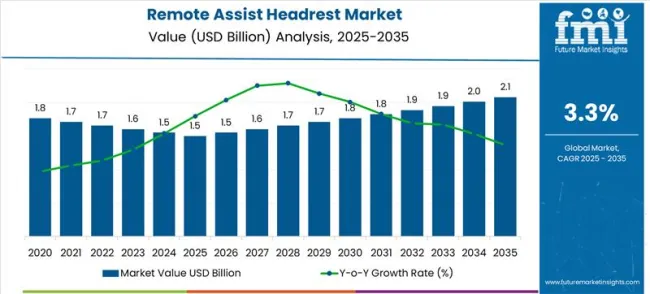
Between 2025 and 2030, the remote assist headrest market is projected to expand from USD 1.5 billion to USD 1.8 billion, resulting in a value increase of USD 0.3 billion, which represents 50.0% of the total forecast growth for the decade. This phase of development will be shaped by increasing automotive technology adoption, rising demand for connected interior systems, and growing utilisation in advanced passenger comfort and communication applications. Equipment manufacturers and automotive technology specialists are expanding their product portfolios to address the growing preference for high-performance remote assist headrest systems in premium vehicle operations.
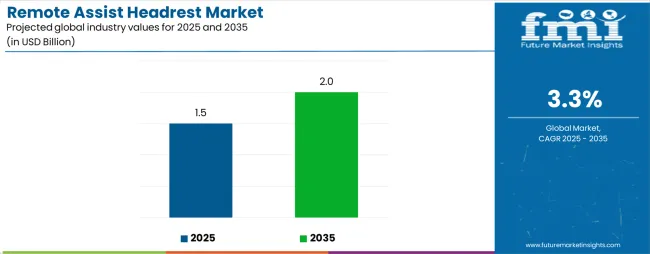
| Metric | Value |
|---|---|
| Estimated Value in (2025E) | USD 1.5 billion |
| Forecast Value in (2035F) | USD 2.0 billion |
| Forecast CAGR (2025 to 2035) | 3.3% |
From 2030 to 2035, the market is forecast to grow from USD 1.8 billion to USD 2.0 billion, adding another USD 0.3 billion, which constitutes 50.0% of the overall ten-year expansion. This period is expected to be characterised by the expansion of advanced communication technologies, the integration of smart connectivity capabilities for premium headrest equipment, and the development of enhanced audio-visual system formulations for specialised applications. The growing emphasis on connected mobility and precision passenger services will drive demand for sophisticated remote assist headrests with enhanced performance characteristics and improved operational connectivity.
Between 2020 and 2024, the remote assist headrest market experienced steady growth, driven by increasing automotive sector investments and growing recognition of connected interior systems' superior functionality capabilities across premium vehicles, luxury segments, and advanced passenger comfort applications. The market developed as manufacturers recognised the potential for advanced communication technologies to enhance passenger experience while meeting automotive requirements for consistent performance and reliability. Technological advancement in system efficiency and connectivity began emphasising the critical importance of maintaining functionality while extending equipment lifespan and improving passenger engagement effectiveness.
Market expansion is being supported by the increasing global demand for automotive connectivity solutions and the corresponding shift toward advanced communication technologies that can provide a superior passenger experience while meeting industry requirements for consistent and reliable vehicle integration. Modern automotive facilities and manufacturing operations are increasingly focused on incorporating high-performance remote assist headrests to enhance passenger comfort while satisfying demands for connected vehicle capabilities and automated communication systems. Remote assist headrests' proven ability to deliver superior connectivity, operational reliability, and passenger control makes them essential equipment for advanced automotive installations and premium vehicle applications.
The growing emphasis on automotive connectivity and vehicle integration is driving demand for high-quality remote assist headrest products that can support distinctive passenger processes and premium vehicle positioning across luxury, premium, and mass-market categories. The automotive industry's preference for headrests that combine performance excellence with advanced connectivity capabilities is creating opportunities for innovative communication implementations in both traditional and emerging automotive applications. The rising influence of connected vehicle technologies and integrated mobility systems is also contributing to increased adoption of premium remote assist headrest products that can provide authentic smart automotive integration characteristics
The remote assist headrest market represents a stable automotive opportunity at the intersection of vehicle connectivity, precision engineering, and communication technology, with the market projected to expand from USD 1.5 billion in 2025 to USD 2.0 billion by 2035 at a steady 3.3% CAGR-a 1.4X growth driven by increasing automotive connectivity requirements, premium vehicle adoption, and the integration of advanced communication control systems into passenger experiences.
This convergence opportunity leverages the necessity of automotive connectivity, the demand for consistent passenger communication, and advances in headrest technology to create systems that offer reliable performance in critical passenger applications. The audio-only feature set segment leads with 40.0% market share due to its optimal balance of functionality and cost-effectiveness for most automotive applications, while rear-seat entertainment use cases dominate with 45.0% share as the preferred application for passenger comfort. Geographic growth is strongest in Germany (3.9% CAGR) and China (3.6% CAGR), where expanding automotive sectors and infrastructure development create ideal market conditions.
The market is segmented by feature set, integration type, use case, and region. The demand for the feature set is divided into audio-only, audio + video, and enhanced (ANC/haptics) systems. Based on integration type, the market is categorised into OEM, factory-fit and aftermarket applications. The use case is segmented into rear-seat entertainment, teleconferencing, emergency/concierge, and accessibility/assistive applications. Regionally, the market is divided into North America, Europe, Asia Pacific, Latin America, and the Middle East & Africa.
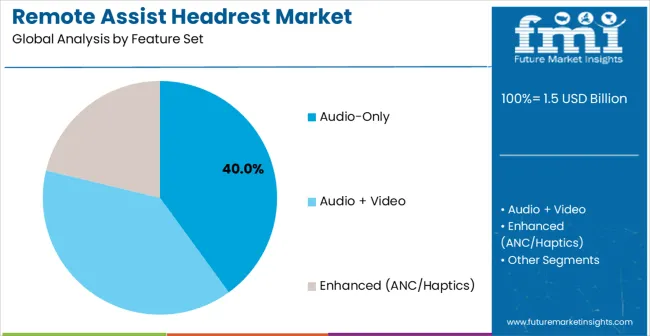
The audio-only feature set segment is projected to account for 40.0% of the remote assist headrest market in 2025, reaffirming its position as the leading feature category. Automotive equipment manufacturers and vehicle facilities increasingly utilise audio-only systems for their optimal balance of functionality, cost-effectiveness, and versatility in communication applications across diverse automotive installations. This feature set's standardised performance characteristics and reliable operation directly address the automotive requirements for consistent quality control and efficient passenger communication in connected vehicle operations.
This feature set segment forms the foundation of modern automotive communication applications, as it represents the headrest category with the greatest cost-effectiveness potential and established compatibility across multiple integration configurations and use case applications. Manufacturer investments in system optimisation and audio control integration continue to strengthen adoption among automotive equipment producers. With manufacturers prioritising operational efficiency and consistent performance, audio-only systems align with both functionality objectives and quality assurance requirements, making them the central component of comprehensive automotive communication strategies.
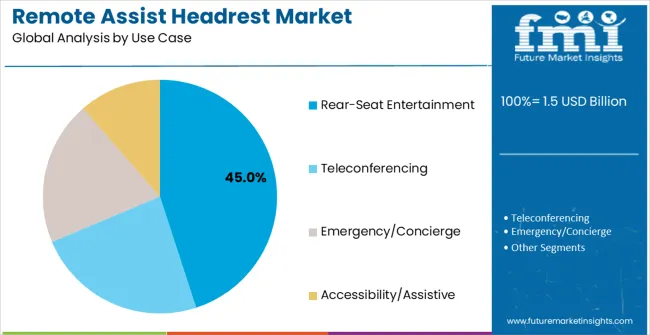
Rear-seat entertainment use case applications are projected to represent the largest share of remote assist headrest demand in 2025, with 45.0% market share, underscoring their critical role as the primary application for passenger comfort operations in automotive and vehicle environments. Equipment manufacturers and automotive facilities prefer rear-seat entertainment applications for their exceptional user experience characteristics, entertainment capabilities, and ability to maintain consistent passenger satisfaction while supporting advanced communication requirements during premium vehicle operations. Positioned as essential equipment for high-performance automotive installations, rear-seat entertainment remote assist headrests offer both operational reliability and passenger engagement advantages.
The segment is supported by continuous growth in premium vehicle adoption and the growing availability of advanced entertainment systems that enable enhanced operational control and passenger satisfaction at the automotive facility level. Additionally, manufacturers are investing in premium entertainment configurations to support passenger experience enhancement and vehicle differentiation strategies. As premium vehicles continue to expand and facilities seek superior entertainment solutions, rear-seat entertainment applications will continue to dominate the use case landscape while supporting technology advancement and operational optimisation strategies.
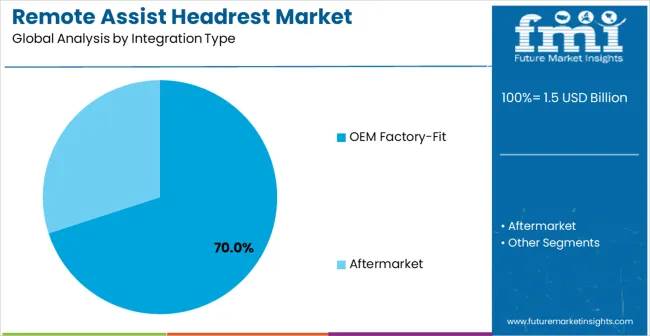
OEM factory-fit integration applications are projected to represent the largest share of remote assist headrest demand in 2025, with 70.0% market share, underscoring their critical role as the primary integration category for seamless automotive operations in manufacturing and vehicle environments. Equipment manufacturers and automotive facilities prefer OEM factory-fit applications for their exceptional integration characteristics, quality assurance capabilities, and ability to maintain consistent manufacturing standards while supporting advanced communication requirements during precision automotive operations. Positioned as essential equipment for high-performance automotive installations, OEM factory-fit remote assist headrests offer both operational reliability and manufacturing optimisation advantages.
The segment is supported by continuous growth in automotive manufacturing adoption and the growing availability of advanced factory-fit systems that enable enhanced operational control and quality optimisation at the automotive facility level. Additionally, manufacturers are investing in premium factory-fit configurations to support production quality enhancement and vehicle integration experiences. As automotive manufacturing continues to expand and facilities seek superior integration solutions, OEM factory-fit applications will continue to dominate the integration landscape while supporting technology advancement and operational optimisation strategies.
The remote assist headrest market is advancing steadily due to increasing automotive connectivity adoption and growing demand for communication solutions that emphasise superior passenger experience across premium vehicles, luxury segments, and mass-market applications. However, the market faces challenges, including high equipment costs compared to basic alternatives, technical complexity in system integration, and competition from alternative communication technologies. Innovation in system efficiency and smart connectivity continues to influence market development and expansion patterns.
The growing adoption of remote assist headrests in comprehensive automotive operations and connected vehicle applications is enabling equipment manufacturers to develop products that provide distinctive communication capabilities while commanding premium positioning and enhanced operational characteristics. Advanced applications provide superior connectivity while allowing more sophisticated automotive development across various vehicle categories and technology segments. Manufacturers are increasingly recognising the competitive advantages of connectivity positioning for premium product development and automotive market penetration.
Modern remote assist headrest suppliers are incorporating advanced energy management systems, smart connectivity technologies, and usage optimisation algorithms to enhance operational efficiency, improve energy conservation, and meet automotive demands for sustainable and cost-effective passenger solutions. These programs improve equipment performance while enabling new applications, including energy-smart manufacturing and automated communication management systems. Advanced efficiency integration also allows suppliers to support premium market positioning and sustainability leadership beyond traditional commodity automotive communication equipment products.
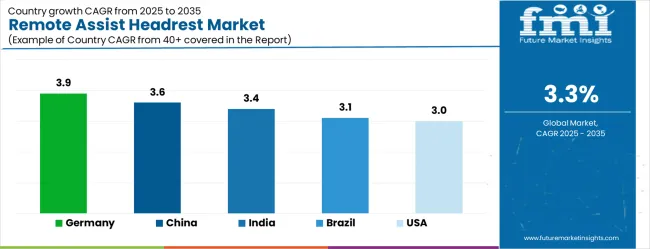
| Country | CAGR (2025 to 2035) |
|---|---|
| Germany | 3.9% |
| China | 3.6% |
| India | 3.4% |
| Brazil | 3.1% |
| USA | 3.0% |
The remote assist headrest market is experiencing varied growth globally, with Germany leading at a 3.9% CAGR through 2035, driven by the premium automotive manufacturing sector, substantial investments in vehicle technology infrastructure, and increasing adoption of advanced interior systems. China follows at 3.6%, supported by growing automotive development, rising vehicle investments, and expanding connected vehicle activities. India shows growth at 3.4%, emphasising automotive market expansion and premium vehicle development. Brazil records 3.1%, focusing on automotive technology applications and vehicle modernisation advancement. The USA demonstrates 3.0% growth, prioritising automotive innovation and interior equipment development.
The report covers an in-depth analysis of 40+ countries; five top-performing countries are highlighted below.
Revenue from remote assist headrests in Germany is projected to exhibit exceptional growth with a CAGR of 3.9% through 2035, driven by the premium automotive manufacturing sector and substantial investments in vehicle technology diversification programs across major automotive centres. The country's growing automotive base and increasing adoption of connected headrest technologies are creating significant demand for precision remote assist headrest equipment in both premium vehicle manufacturing and luxury automotive applications. Major automotive equipment manufacturers and headrest system companies are establishing comprehensive distribution and service capabilities to serve both domestic consumption and regional export markets.
Revenue from remote assist headrests in China is expanding at a CAGR of 3.6%, supported by growing automotive development, increasing vehicle investments, and extending connected vehicle capabilities with modern technology features. The country's developing automotive ecosystem and expanding vehicle infrastructure are driving demand for reliable remote assist headrest products across both traditional automotive manufacturing and emerging connected vehicle applications. International equipment companies and domestic headrest manufacturers are establishing comprehensive production and distribution capabilities to address growing market demand for automotive communication solutions.
Revenue from remote assist headrests in India is projected to grow at a CAGR of 3.4% through 2035, driven by the country's automotive market expansion, vehicle technology development capabilities, and leadership in regional automotive solutions. India's growing automotive culture and willingness to invest in technology equipment are creating substantial demand for both standard and premium remote assist headrest varieties. Leading equipment companies and headrest manufacturers are establishing comprehensive development strategies to serve both Asian markets and growing international demand.
Revenue from remote assist headrests in Brazil is projected to grow at a CAGR of 3.1% through 2035, supported by the country's automotive market development, vehicle technology advancement capabilities, and established market for premium automotive equipment solutions. Brazilian manufacturers and automotive facility operators consistently seek innovative equipment products that enhance passenger experience for both traditional automotive applications and advanced vehicle markets. The country's position as an automotive technology hub continues to drive innovation in vehicle automation applications and equipment standards.
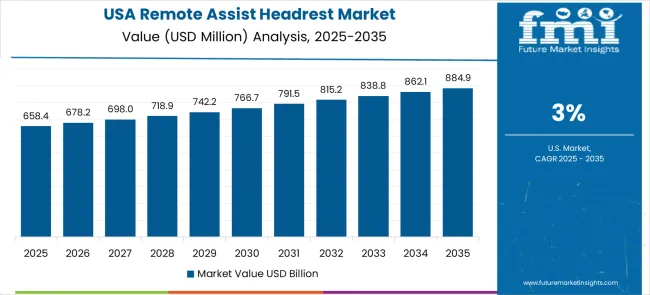
Revenue from remote assist headrests in the USA is projected to grow at a CAGR of 3.0% through 2035, supported by the country's advanced automotive sector, innovation leadership capabilities, and established market for premium vehicle equipment solutions. American manufacturers and automotive facility operators prioritise innovation, reliability, and technical excellence, making remote assist headrests essential equipment for both automotive modernisation and new vehicle projects. The country's comprehensive automotive ecosystem and adoption patterns support continued market development.
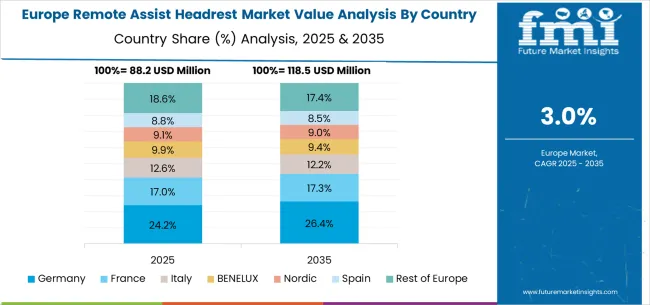
The remote assist headrest market in Europe is projected to grow from USD 0.4 billion in 2025 to USD 0.6 billion by 2035, registering a CAGR of 3.4% over the forecast period. Germany is expected to maintain its leadership position with a 35.2% market share in 2025, remaining stable at 35.0% by 2035, supported by its advanced automotive engineering sector, premium vehicle equipment manufacturing industry, and comprehensive innovation capabilities serving European and international markets.
France follows with a 22.8% share in 2025, projected to reach 23.1% by 2035, driven by advanced automotive technology adoption programs, vehicle engineering development capabilities, and growing focus on automotive technology solutions for premium vehicle facilities. The United Kingdom holds an 18.4% share in 2025, expected to maintain 18.2% by 2035, supported by automotive innovation market demand and advanced technology applications, but facing challenges from market competition and economic considerations. Italy commands a 12.6% share in 2025, projected to reach 12.8% by 2035, while Spain accounts for 7.3% in 2025, expected to reach 7.5% by 2035. The Netherlands maintains a 3.7% share in 2025, growing to 3.8% by 2035. The Rest of Europe region, including Nordic countries, Eastern Europe, Belgium, Switzerland, and Austria, is anticipated to hold 18.6% in 2025, declining slightly to 18.4% by 2035, attributed to mixed growth patterns with strong expansion in some Nordic automotive markets balanced by moderate growth in smaller countries implementing automotive modernisation programs.
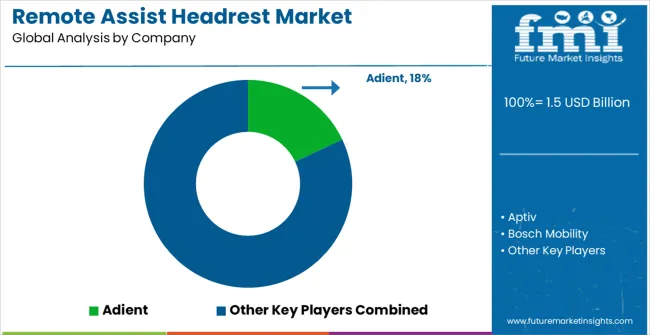
The remote assist headrest market is characterised by competition among established automotive interior equipment manufacturers, specialised vehicle technology companies, and integrated connectivity solution providers. Companies are investing in advanced communication control technologies, passenger experience optimisation systems, application-specific product development, and comprehensive performance enhancement capabilities to deliver consistent, high-performance, and reliable remote assist headrest products. Innovation in connectivity enhancement, audio control optimisation, and customised automotive compatibility is central to strengthening market position and customer satisfaction.
Adient leads the market with a strong focus on automotive interior innovation and comprehensive vehicle solutions, offering advanced remote assist headrest products that emphasise reliability and technology integration excellence. Aptiv provides specialised automotive technology capabilities with a focus on connectivity, manufacturing, and market leadership. Bosch Mobility delivers comprehensive automotive solutions with a focus on vehicle applications and operational reliability. Denso specialises in automotive equipment with an emphasis on precision and integration capabilities. Faurecia (Forvia) focuses on advanced automotive technologies and interior systems. Gentherm emphasises automotive comfort expertise with a focus on system integration and passenger experience.
| Items | Values |
|---|---|
| Quantitative Units (2025) | USD 1.5 billion |
| Feature Set | Audio-Only, Audio + Video, Enhanced (ANC/Haptics) |
| Integration Type | OEM Factory-Fit, Aftermarket |
| Use Case | Rear-Seat Entertainment, Teleconferencing, Emergency/Concierge, Accessibility/Assistive |
| Regions Covered | North America, Europe, Asia Pacific, Latin America, Middle East & Africa |
| Countries Covered | United States, Canada, United Kingdom, Germany, France, China, Japan, South Korea, India, Brazil, Australia and 40+ countries |
| Key Companies Profiled | Adient, Aptiv, Bosch Mobility, Denso, Faurecia (Forvia), Gentherm, Hyundai Mobis, Lear Corporation, Toyota Boshoku, and Valeo |
| Additional Attributes | Dollar sales by feature set and integration type, regional demand trends, competitive landscape, technological advancements in communication control systems, automotive connectivity integration initiatives, passenger experience optimisation programs, and operational performance enhancement strategies |
The global remote assist headrest market is estimated to be valued at USD 1.5 billion in 2025.
The market size for the remote assist headrest market is projected to reach USD 2.0 billion by 2035.
The remote assist headrest market is expected to grow at a 3.0% CAGR between 2025 and 2035.
The key product types in remote assist headrest market are audio-only, audio + video and enhanced (anc/haptics).
In terms of integration type, oem factory-fit segment to command 70.0% share in the remote assist headrest market in 2025.






Our Research Products

The "Full Research Suite" delivers actionable market intel, deep dives on markets or technologies, so clients act faster, cut risk, and unlock growth.

The Leaderboard benchmarks and ranks top vendors, classifying them as Established Leaders, Leading Challengers, or Disruptors & Challengers.

Locates where complements amplify value and substitutes erode it, forecasting net impact by horizon

We deliver granular, decision-grade intel: market sizing, 5-year forecasts, pricing, adoption, usage, revenue, and operational KPIs—plus competitor tracking, regulation, and value chains—across 60 countries broadly.

Spot the shifts before they hit your P&L. We track inflection points, adoption curves, pricing moves, and ecosystem plays to show where demand is heading, why it is changing, and what to do next across high-growth markets and disruptive tech

Real-time reads of user behavior. We track shifting priorities, perceptions of today’s and next-gen services, and provider experience, then pace how fast tech moves from trial to adoption, blending buyer, consumer, and channel inputs with social signals (#WhySwitch, #UX).

Partner with our analyst team to build a custom report designed around your business priorities. From analysing market trends to assessing competitors or crafting bespoke datasets, we tailor insights to your needs.
Supplier Intelligence
Discovery & Profiling
Capacity & Footprint
Performance & Risk
Compliance & Governance
Commercial Readiness
Who Supplies Whom
Scorecards & Shortlists
Playbooks & Docs
Category Intelligence
Definition & Scope
Demand & Use Cases
Cost Drivers
Market Structure
Supply Chain Map
Trade & Policy
Operating Norms
Deliverables
Buyer Intelligence
Account Basics
Spend & Scope
Procurement Model
Vendor Requirements
Terms & Policies
Entry Strategy
Pain Points & Triggers
Outputs
Pricing Analysis
Benchmarks
Trends
Should-Cost
Indexation
Landed Cost
Commercial Terms
Deliverables
Brand Analysis
Positioning & Value Prop
Share & Presence
Customer Evidence
Go-to-Market
Digital & Reputation
Compliance & Trust
KPIs & Gaps
Outputs
Full Research Suite comprises of:
Market outlook & trends analysis
Interviews & case studies
Strategic recommendations
Vendor profiles & capabilities analysis
5-year forecasts
8 regions and 60+ country-level data splits
Market segment data splits
12 months of continuous data updates
DELIVERED AS:
PDF EXCEL ONLINE
Remote ICU Monitoring System Market Size and Share Forecast Outlook 2025 to 2035
Remote Lockout Tool Market Size and Share Forecast Outlook 2025 to 2035
Remote Desktop Software Market Forecast and Outlook 2025 to 2035
Remote Patient Monitoring Devices Market Size and Share Forecast Outlook 2025 to 2035
Remote Endarterectomy Devices Market Size and Share Forecast Outlook 2025 to 2035
Remote Electrocardiogram Monitoring Market Size and Share Forecast Outlook 2025 to 2035
Remote Valve Tissue Expanders Market Size and Share Forecast Outlook 2025 to 2035
Remote Patient Monitoring System Market Size and Share Forecast Outlook 2025 to 2035
Remote Imaging Collaboration Market Analysis - Size, Share, and Forecast Outlook 2025 to 2035
Remote Operated Vehicle Market Size and Share Forecast Outlook 2025 to 2035
Remote DC Microgrid Market Size and Share Forecast Outlook 2025 to 2035
Remote Microgrid Market Size and Share Forecast Outlook 2025 to 2035
Remote Towers Market Size and Share Forecast Outlook 2025 to 2035
Remote AF Detection Tools Market Analysis Size and Share Forecast Outlook 2025 to 2035
Remote Vehicle Diagnostics Market Size and Share Forecast Outlook 2025 to 2035
Assisted Walking Devices Market Size and Share Forecast Outlook 2025 to 2035
Remote Home Monitoring Systems Market Size and Share Forecast Outlook 2025 to 2035
Remote Asset Management Market Size and Share Forecast Outlook 2025 to 2035
Assisted Living Software Market by Deployment, Amenity Type, and Region-Forecast through 2035
Remote Learning Technology Spending Market Analysis by Technology Software, Technology Services, Learning Mode, End User and Region Through 2025 to 2035

Thank you!
You will receive an email from our Business Development Manager. Please be sure to check your SPAM/JUNK folder too.
Chat With
MaRIA